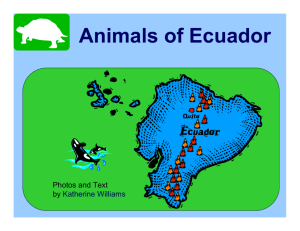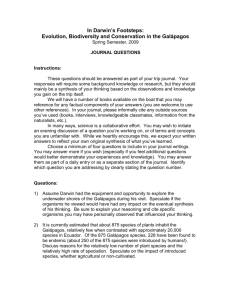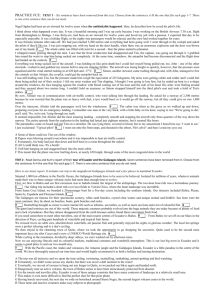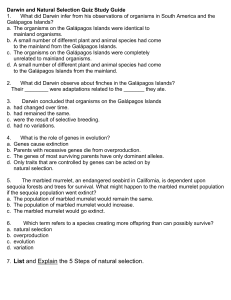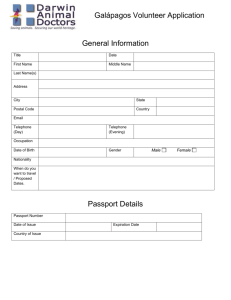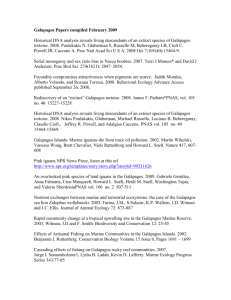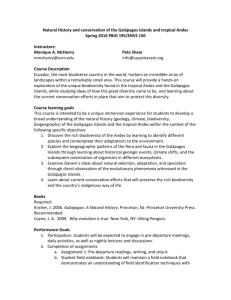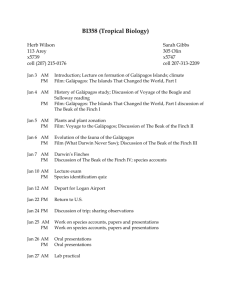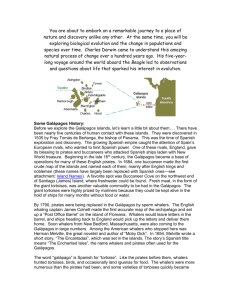Galapagos Exhibition Guide
advertisement
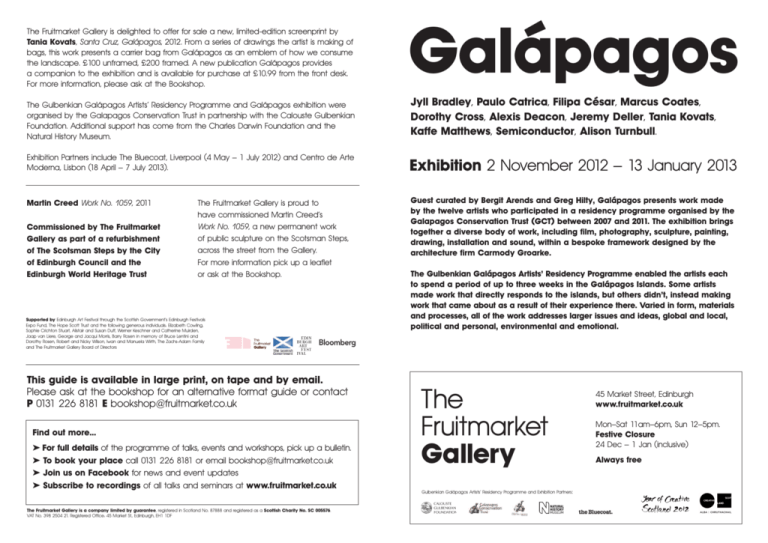
The Fruitmarket Gallery is delighted to offer for sale a new, limited-edition screenprint by Tania Kovats, Santa Cruz, Galápagos, 2012. From a series of drawings the artist is making of bags, this work presents a carrier bag from Galápagos as an emblem of how we consume the landscape. £100 unframed, £200 framed. A new publication Galápagos provides a companion to the exhibition and is available for purchase at £10.99 from the front desk. For more information, please ask at the Bookshop. Galápagos The Gulbenkian Galápagos Artists’ Residency Programme and Galápagos exhibition were organised by the Galapagos Conservation Trust in partnership with the Calouste Gulbenkian Foundation. Additional support has come from the Charles Darwin Foundation and the Natural History Museum. Jyll Bradley, Paulo Catrica, Filipa César, Marcus Coates, Dorothy Cross, Alexis Deacon, Jeremy Deller, Tania Kovats, Kaffe Matthews, Semiconductor, Alison Turnbull. Exhibition Partners include The Bluecoat, Liverpool (4 May – 1 July 2012) and Centro de Arte Moderna, Lisbon (18 April – 7 July 2013). Exhibition 2 November 2012 – 13 January 2013 Martin Creed Work No. 1059, 2011 Guest curated by Bergit Arends and Greg Hilty, Galápagos presents work made by the twelve artists who participated in a residency programme organised by the Galapagos Conservation Trust (GCT) between 2007 and 2011. The exhibition brings together a diverse body of work, including film, photography, sculpture, painting, drawing, installation and sound, within a bespoke framework designed by the architecture firm Carmody Groarke. Commissioned by The Fruitmarket Gallery as part of a refurbishment of The Scotsman Steps by the City of Edinburgh Council and the Edinburgh World Heritage Trust The Fruitmarket Gallery is proud to have commissioned Martin Creed’s Work No. 1059, a new permanent work of public sculpture on the Scotsman Steps, across the street from the Gallery. For more information pick up a leaflet or ask at the Bookshop. Supported by Edinburgh Art Festival through the Scottish Government’s Edinburgh Festivals Expo Fund, The Hope Scott Trust and the following generous individuals: Elizabeth Cowling, Sophie Crichton Stuart, Alistair and Susan Duff, Werner Keschner and Catherine Muirden, Jaap van Liere, George and Jacqui Morris, Barry Rosen in memory of Bruce Lentini and Dorothy Rosen, Robert and Nicky Wilson, Iwan and Manuela Wirth, The Zachs-Adam Family and The Fruitmarket Gallery Board of Directors This guide is available in large print, on tape and by email. Please ask at the bookshop for an alternative format guide or contact P 0131 226 8181 E bookshop@fruitmarket.co.uk Find out more... ➤ For full details of the programme of talks, events and workshops, pick up a bulletin. ➤ To book your place call 0131 226 8181 or email bookshop@fruitmarket.co.uk ➤ Join us on Facebook for news and event updates ➤ Subscribe to recordings of all talks and seminars at www.fruitmarket.co.uk The Fruitmarket Gallery is a company limited by guarantee, registered in Scotland No. 87888 and registered as a Scottish Charity No. SC 005576. VAT No. 398 2504 21. Registered Office: 45 Market St., Edinburgh, EH1 1DF The Gulbenkian Galápagos Artists’ Residency Programme enabled the artists each to spend a period of up to three weeks in the Galápagos Islands. Some artists made work that directly responds to the islands, but others didn’t, instead making work that came about as a result of their experience there. Varied in form, materials and processes, all of the work addresses larger issues and ideas, global and local, political and personal, environmental and emotional. The Fruitmarket Gallery Gulbenkian Galápagos Artists’ Residency Programme and Exhibition Partners: 45 Market Street, Edinburgh www.fruitmarket.co.uk Mon–Sat 11am–6pm, Sun 12–5pm. Festive Closure 24 Dec – 1 Jan (inclusive) Always free Before the sixteenth century, there were no human residents on the Galápagos Islands, an archipelago of 120 islands located off the west coast of Ecuador. Since then, the introduction of non-native animal species and the relatively recent migration of Ecuadorians to four of the islands have dramatically changed the unique ecosystem which led to the publication of Charles Darwin’s monumental work on natural selection, On the Origin of Species by Means of Natural Selection (1859). In his essay for the catalogue that accompanies this exhibition, the palaeontologist Richard Fortey extends the familiar view of the Galápagos as a ‘natural evolutionary laboratory’ supporting the creation of life to propose that it is also a laboratory for ideas and the development of artistic practice. The strangeness and singularity of the Galápagos Islands, and the unresolved tensions between native and non-native inhabitants are two dominant themes in the exhibition. The artist Dorothy Cross (b. 1956, Cork, Ireland) speaks to both themes in her work. In Whale (2011), Cross suspends above an empty, rusty bucket the skeleton of a Cuvier whale, a species native to both the Galápagos and the British Isles; she found the skeleton washed up on the shore of near her home in Ireland. Barnacles are by contrast, native to the whole world; they also happened to be an obsession of Charles Darwin’s. Tania Kovats (b. 1966, Brighton) describes her interest in barnacles as arising from their status as ‘in-between sorts of things…in between animals and landscape’, clinging on to the landscape to stay alive. The sculpture Colony (2012) features a colony of inverted barnacles, individual barnacles turning in on themselves as they grew. She writes about how her visit to the Galápagos provided her with a new sculptural language. Back home in England, Kovats preserved a road-kill badger in the same ‘in between’ state she found it: as an animal violently caught between natural and human landscapes. Several artists spent more time with the human occupants rather than the animals of the islands. Jyll Bradley’s (b. 1966, Folkestone) interest in tourists, gardening groups and the effects of sunlight resulted in a series of photographs and abstract works. She turned her lens to tourists in the landscape in her work Audiences (Galápagos) (2012); the series of drawings in Vessels (2012) evoke a sense of the islands’ brilliant light. More bloody social rituals are the focus of Jeremy Deller’s (b. 1966, London) Cockfight (2010), where the squawks of sparring cockerels are mirrored and overshadowed by the skirmishes between their owners. Social codes and scientific systems feature in the series of works by Alison Turnbull (b. 1956, Bogotá). Specimens (2012) and Species (2012) are abstract and representational, presenting the taxonomic systems used to order natural history collections of individual specimens. Similarly, she juxtaposes symbolic abstract forms with representational imagery in her series of works bringing together photographs of everyday life in Santa Cruz alongside her abstract drawings on school writing paper. In her paintings featuring the Galápagos flag and civic injunctions about nature and education, Turnbull breaks down their elements into a series of fine silverpoint lines and enamel dots, pushing already abstract symbols further into the realm of the visual, thereby subverting their symbolic meanings. By contrast, Paulo Catrica (b. 1965, Lisbon) looks more closely at the architectural landscape of the islands. Although Catrica was based in the two most largely populated towns on the islands, no human beings inhabit his photographs; instead, his subject is what he calls the ‘social landscape’, where the built environment merges seamlessly into the natural environment. The artist also includes an archive, Baltra (2010), a collection of photographs, texts, an architectural drawing and a map that offer a wider understanding of the human occupation of Baltra. These materials can be viewed by opening the drawers. In his video projection Human Report (2008), Marcus Coates (b. 1968, London) brings animals and human communities into an unusual dialogue. Coates takes the form of a blue-footed booby, one of the most photographed animals on the Galápagos, to broadcast his own report on humans on Channel 9 in the Galápagos. The bird asks frank questions about humans, the species he calls ‘strange, comical creatures with beautiful markings’, and their cultural and behavioural codes, from the disposal of waste to the feeding of children. Ultimately, it addresses the more absurd aspects of how humans organize, or fail to organize, themselves in the wider world. A more mysterious blurring of reality and fiction can be found in Morel’s Yellow Pages (2012), a film by Filipa César (b. 1975, Porto) which focuses on secretive and destructive actions and image making. Her title references The Invention of Morel (1940), Adolfo Bioy Casares’s science fiction novel which informs the work. The artist brings together her research into the use of Baltra Island as an air base for the US army during the Second World War and aerial surveillance photographs of the islands with film footage, documents and factual information collected during her trip to the Galápagos to interweave fact and fiction, covert and imagined activities. An extract from the novel accompanies the film and is available to take away. (The novel is available for perusal in the Resource Room upstairs.) Upstairs, animal life and the environment are the dominant subjects. During her residency, Kaffe Matthews (b. 1961, Essex) was drawn to hammerhead sharks, an endangered species in the Galápagos. In You might come out of the water every time singing (2012), Matthews collaborated with a marine biologist and a programmer to transform data associated with migratory diving patterns recorded from acoustic tracking devices following six hammerhead sharks through the Pacific Ocean in Spring 2009. Information such as latitude, longitude, depth, temperature and speed is rendered sonic, representing the sharks’ swooping, swirling and hovering movements through the ocean. (You are encouraged to take off your shoes and sit or lie on the platform.) Alexis Deacon (b. 1978, London) presents a selection of his drawings made in the Galápagos, from his observations of animal life to studies for a children’s graphic novel. He hoped his work might ‘show a little of the wonder’ he felt from what he found there. Close inspection reveals a host of wonders: a talking blue-footed booby, a crew of shipwrecked sailors founding a new Spain on the islands, and the transformation of falling golden animals into a luminescent tree of human figures. Volcanic activity in the Galápagos is the subject of works by Semiconductor (Ruth Jarman, b. 1973, Fareham and Joe Gerhardt, b. 1972, Oxford). Most of the islands in the Galápagos represent the summit of a volcano, and the western islands in the archipelago still experience volcanic and seismic activity. The artists used seismic data to make the animation in the film Worlds in the Making (2011), and a set of seismographic drawings also represent this activity on both the monumental and small scales, from panoramic views to minuscule variegated markings. From the monumental movements of the earth to the ephemeral life of a Cuvier whale, Galápagos presents works that offer glimpses into the variety of lives on the islands and the finitude of those lives. The co-curator Bergit Arends notes, ‘the artists have created both an elegy and a plea for nature’. As Kaffe Matthews writes of her experience of swimming with hammerhead sharks, ‘You don’t feel scared at all, just, blimey: “Let me worship at the portal of your evolutionary perfection. How feeble am I in your presence!”‘
